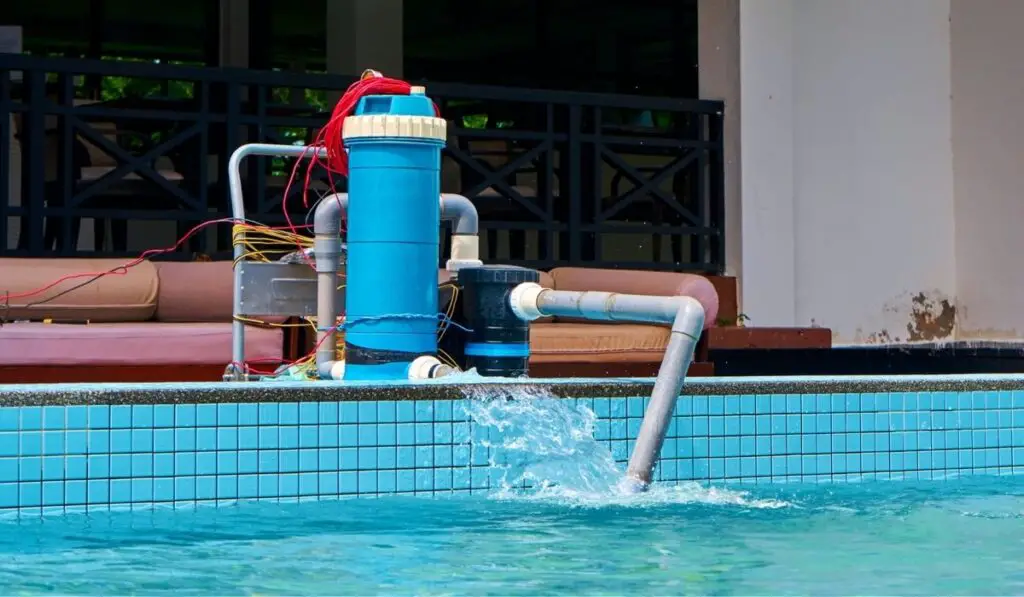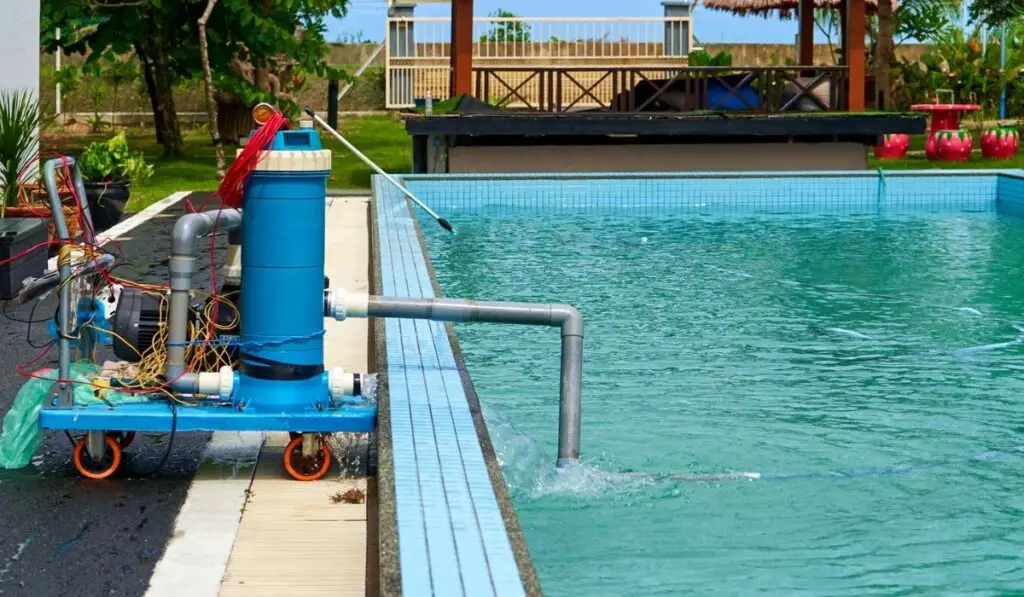The swimming pool is a source of great pleasure, but it can also cause many irritating inconveniences, especially if it’s not cared for properly. Routine maintenance keeps your swimming pool clean and healthy, and backwashing is one of the key pool maintenance practices.
Backwashing involves cleaning the pool filter without removing it by reversing the direction of the water flowing through it. The result is a healthy and effective pool filtration system. Backwashing should be done at least once a week, or more if necessary (especially if the flow seems to slow).
Backwashing is a simple process that typically takes a few minutes to complete. While you can engage the services of an expert for backwashing, it’s easy enough to do by yourself. Read on to find out how to backwash, how often you should do it, and the tips and tricks to get you started.
What Does Backwashing a Pool Mean?

Backwashing a pool’s sand filter, like this Intex model for reference (on Amazon), is a method that flushes out accumulated debris that may be restricting the flow of water through the filtration system. It involves reversing the direction of the water flow through the filter and out the drain port. This action dislodges and flushes out the trapped debris to restore smooth water circulation.
A pool’s filtration system typically cleans the water by passing it through a porous filter that traps debris and contaminants. These particles build up in the filter over time, resulting in increased resistance to flow.
If left unremoved, the particles can cause pressure build up and eventual damage to the filtration system. Regular backwashing is recommended to keep your filters in peak working condition.
How Often Should You Backwash Your Pool?
One of the most common concerns for pool owners is how often they need to backwash their pool. The frequency of backwashing a pool’s filters depends on a range of factors. One of them is how much you use your pool.
A pool will get dirtier the more it’s used, so more frequently used pools require more frequent backwashing. Smaller pools also require more frequent backwashing compared to larger pools since they are likely to accumulate debris much faster.
The location of your pool can also determine how frequently you need to backwash your pool. A pool that is surrounded by overhanging trees and shrubs will require frequent backwashing, especially if it’s left uncovered when not in use.
The type of filter you use may also determine how frequently you have to backwash. While there are many filters in the market today, sand filters are the most popular for their fineness of filtration and ease of backwashing.
Unfortunately, the small gaps between the sand grins that produce fine filtration are easily clogged by debris and regular backwashing is therefore necessary to unclog them.
There is no strict rule about how often you need to backwash your pool, but it’s generally accepted that you should do it at least once a week. There are some common signs that should guide your backwashing schedule. These include:
- Water Pressure: An increase in your filter’s pressure gauge reading by 8-10 PSI (pounds per square inch) above the starting level indicates that your pool’s filter is under strain, most likely due to blockage. You should backwash to unclog the filter system and reduce the pressure to a normal reading.
- Water Flow: Water passing through the filter at a reduced rate is also an indicator of a clogged filter. You should backwash to improve the water flow rate.
- Water Clarity: Cloudy water indicates that some debris is seeping back into the pool. This could be due to a clogged filter. An abnormal amount of dirt or debris getting into your pool, especially after a storm, can clog up the filter and affect its functionality. You should backwash to unclog the filters and allow them to clean the water more effectively.
How to Backwash a Pool
Backwashing a pool is a straightforward process that you can do yourself. As its name suggests, it simply involves reversing the flow of water through the filter to flush out the debris trapped in the filter. The polluted water is then expelled into the drain as waste.
How you backwash your pool depends on the filter type. If possible, consult the filter manufacturer’s website to get the best instructions for your filter model.
Here are the standard instructions to get you started:
How to Backwash your Sand Filter
Apart from changing the sand, backwashing is the only way to clean a sand filter. It is a relatively easy process that only takes 2-3 minutes, but it requires a significant amount of water. You won’t have to remove the sand from your filter. All you need is a backwash hose (on Amazon).
Multiport Vs. Push-Pull Valve
Your sand filter may feature either a multiport or a push-pull valve. Each has its own process for backwashing.
Multiport Valve
A multiport valve is located on the top or side of the filter tank. Most have seven positions that control the filter’s functionality. Use the backwash position to flush dirt and debris from inside your filter. Here are the steps to backwash your pool filter with a multiport valve:
- Turn off the pool’s filter system.
- Attach the backwash hose to the filter’s backwash or waste port.
- Switch the multiport valve to “Backwash” position.
- Turn on the pool’s filter system.
- Allow the water to run out of the backwash port through the backwash hose for one to two minutes, or until the water coming out is clear.
- Turn the filter system off again.
- Switch the multiport valve to the “Rinse” position.
- Turn on the filter system and let it run for 30 seconds to a minute. This should settle then sand back to its normal position.
- Turn off the pool’s filter system.
- Switch the multiport valve back to “Filter” position, which is the default setting.
Push-Pull Valve
The sand filter push-pull valve has two positions: up and down. When in the down position, the filter reverses the water flow to backwash and clean the sand in your filter. Using a push-pull valve is much easier. Here are the steps to backwash your pool filter with a push-pull valve:
- Turn off the pool’s filter system.
- Attach the backwash hose to the filter’s backwash or waste port.
- Open the backwash gate.
- Turn on the pool’s filter system and allow it to run for about 3 minutes.
- Turn off the pool’s filter system.
- Close the push-pull valve.
Tips and Tricks

Backwashing your pool should be routine if you want to maintain the functionality and health of your filter. It’s a relatively easy process that you can do by yourself. Here are some tips and tricks to help you along:
- Avoid overdoing the backwashing process to conserve water. Observe the color of the water closely and stop the backwash the moment it becomes clear.
- Always keep the pump turned off when changing the filter valve position and when running a backwash. Keeping it running will likely damage your filtration system permanently.
- A backwash will inevitably wash out some sand from your filter. Make sure you top up the sand regularly to maintain the filter’s optimal performance. Run the rinse setting after the top up to prevent the sand from blowing back into your pool.
- Lubricate the backwash valve often.
- Avoid rushing the reassembly of your filter system after backwashing to avoid mistakes that may cause filter leaks.
